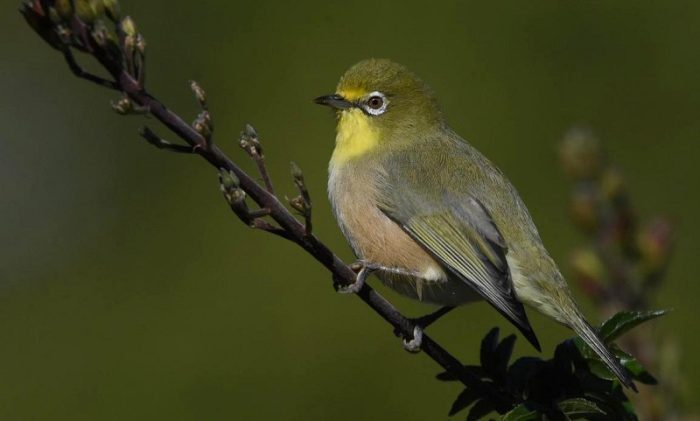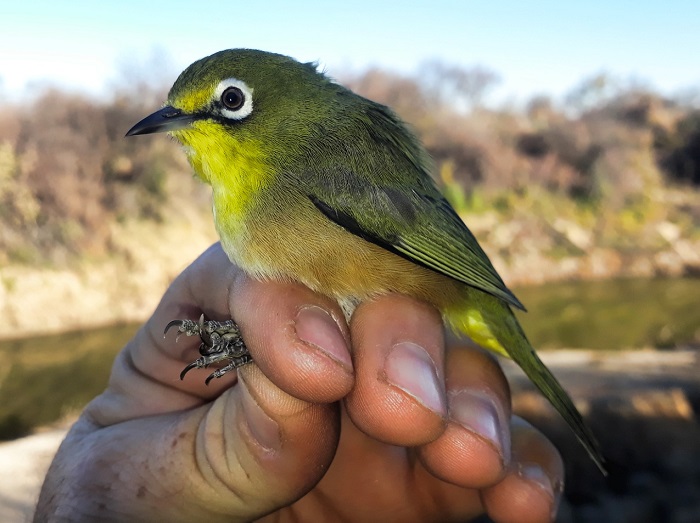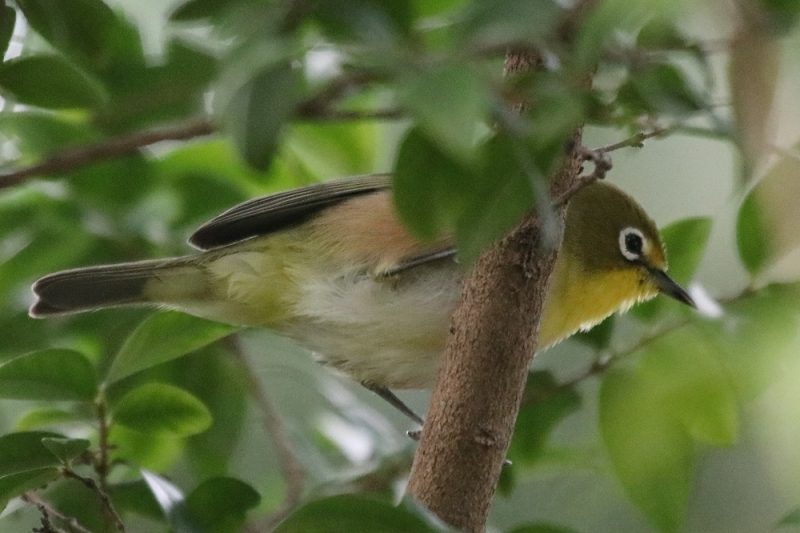Cover image by Sybrand Venter – Carnarvon District, Northern Cape – BirdPix No. 229235 Orange River White-eye
Identification
The Orange River White-eye is the most distinctively marked white-eye in the region. Its most distinguishing feature is the peach-coloured flanks, which are diagnostic. The upperparts are dull olive green. The throat is bright yellow, while the vent is a duller shade of yellow. The broad, white eye-ring is broken by a small black line extending from the base of the beak to the eye. There is a conspicuous yellow supra-loral stripe in front of the eye.

Photo by Janet du Plooy
The sexes are alike and the juveniles are similar but with duller plumage.
It is most similar to the Cape White-eye Zosterops virens and the two were once considered conspecific. The Cape White-eye differs in lacking the peach-coloured flanks. It instead has grey to green undersides which contrast with the yellow throat.

-Bloemfontein, Free State
Photo by Rick Nuttall
Status and Distribution
The Orange River White-eye is common to very common and is endemic to Southern Africa. Occurs in a broad swathe from northern to southern Namibia. In south Africa it is found in the Western Cape, throughout much of the Northern Cape, most of the Free State and parts of North West Province. It is closely linked to the Orange and Vaal River catchments. In the Northern Cape it occurs mainly along the Orange River and its tributaries but has adapted to towns, gardens and farmyards in the semi-arid Karoo.

Details for map interpretation can be found here.
Habitat
The Orange River White-eye is commonly associated with wooded watercourses and drainage lines, where it inhabits thickets with trees and thorny scrub. It is frequent in wooded gardens, parks and towns, favouring poplar (Populus spp) groves, Eucalyptus plantations and rose gardens.

Photo by Marius Meiring
Behaviour
The Orange River White-eye is restless and elusive, moving in small flocks through the foliage. When one area has been gleaned of food, the leader flits to another tree and the remaining flock members follow in ones and twos. Probes in crevices and under bark, and peers under leaves, twigs and branches. Sometimes hangs upside down from a branch to reach food. Most insects are gleaned from leaf surfaces. Reported to mingle with parties of Cape White-eye at some sites. Frequently allopreens.
The diet consists mainly of invertebrates and fruit. Frequently eats hard, dry currant (Searsia spp) berries; these plants are well represented in riverine vegetation throughout its range.

Kimberley, Northern Cape
Photo by Doug Harebottle
Little is known about the breeding habits of this species. They are likely to be monogamous and solitary nesters. They are known to breed during the summer months. Eggs laying has been recorded from October to March. A typical clutch consists of 3 unmarked blue eggs, however, incubation, nestling and fledging periods are unrecorded. Nesting data is probably similar to that of the Cape White-eye (Zosterops virens).

Photo by Rick Nuttall
Further Resources
Species text adapted from the first Southern African Bird Atlas Project (SABAP1), 1997.
The use of photographs by Doug Harebottle, Janet du Plooy, Marius Meiring, Rick Nuttall, Sybrand Venter and Toby Esplin is acknowledged.
Virtual Museum (BirdPix > Search VM > By Scientific or Common Name).
Other common names: Gariepglasogie (Afrikaans); Manqiti (Tswana); Zostérops du fleuve Orange (French); Kaapse Brilvogel (Dutch).
Recommended citation format: Tippett RM 2023. Orange River White-Eye Zosterops pallidus. Biodiversity and Development Institute. Available online at http://thebdi.org/2023/03/20/orange-river-white-eye-zosterops-pallidus/

Photo by Toby Esplin

